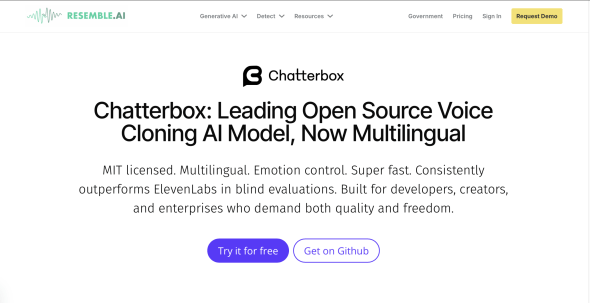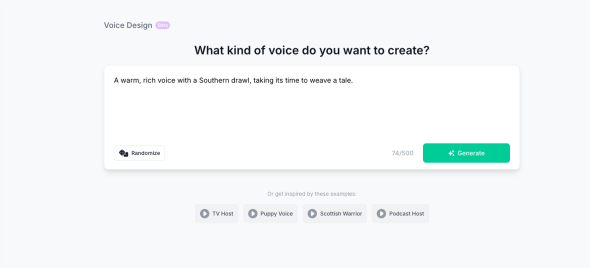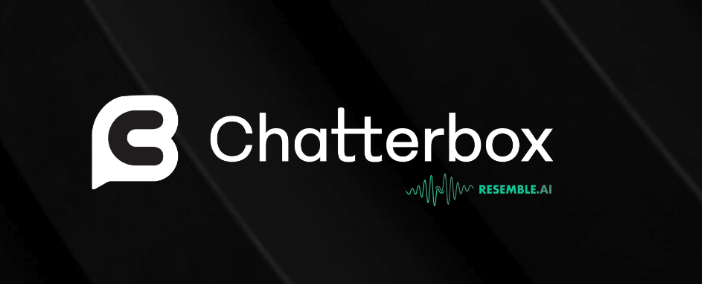Chatterbox by Resemble AI: Free Real-Time AI Voice Cloning with Emotion Control
Chatterbox is an open-source AI model that provides high-fidelity text-to-speech and voice cloning. Developed by Resemble AI and launched in mid-2025. The tool is designed for developers, content creators, and businesses who need realistic, controllable, and human-like voice generation.
Chatterbox is particularly useful for industries like gaming, entertainment, and education. Its primary value proposition is offering a powerful, free, and flexible alternative to closed-source commercial platforms.
The platform disrupts traditional voiceover workflows by enabling users to generate high-quality audio in real-time, complete with emotional nuance, without the need for expensive studio time or voice actors.
Best Use Cases for Chatterbox
- Game Developers: For creators of interactive entertainment, this voice AI solves the challenge of producing vast amounts of dynamic dialogue for non-player characters (NPCs). It can generate thousands of voice lines with varied emotional tones, localize dialogue for global audiences, and allow for rapid prototyping of in-game conversations, significantly reducing production time and costs.
- Content Creators: Podcasters, YouTubers, and audiobook producers can use the tool to create professional-grade voiceovers without needing expensive recording equipment. It allows authors to narrate their own books using their cloned voice, produce multi-character audio dramas, or add consistent, high-quality narration to video content, making production more efficient and affordable.
- AI Application Developers: For those building conversational AI agents or virtual assistants, Chatterbox provides a voice that is natural and expressive. This solves the problem of robotic, monotone text-to-speech that often leads to poor user experiences. The tool’s low latency makes it ideal for real-time applications like interactive voice response (IVR) systems and customer service bots.
- Educators and Corporate Trainers: This voice ai like human helps create engaging and accessible e-learning materials. It can be used to generate voiceovers for training modules, localize educational content for different regions with appropriate accents, and develop personalized, voice-based learning experiences that cater to diverse learning styles.
Completely Free and Open-Source: The tool is MIT-licensed, giving users complete freedom to use, modify, and integrate the model without subscription fees or restrictions.
Advanced Emotion Control: A unique "exaggeration parameter" allows for fine-tuning the emotional intensity of the generated speech, a feature lacking in many competitors.
High-Quality Zero-Shot Cloning: The model can accurately clone a voice ai like human from just a few seconds of audio, making it incredibly efficient to get started.
Low Latency for Real-Time Use: With a latency of around 200ms, it's one of the few models suitable for interactive, real-time voice applications.
Built-In Ethical Safeguards: Includes PerTh neural watermarking technology to help identify AI-generated audio and prevent misuse for deepfakes.
Strong Multilingual Support: The model supports over 23 languages, making it a versatile tool for global projects.
Developer-Friendly: Designed with developers in mind, offering straightforward installation via pip and comprehensive documentation on GitHub and Hugging Face.
Potential for Instability: Some users have noted that the tool can crash when processing very large blocks of text.
No Pre-Made Voice Library: Unlike commercial alternatives, Chatterbox requires you to clone a voice to begin, which may be a hurdle for users without access to clear audio samples.
Minor Audio Artifacts: The emotion exaggeration feature, while powerful, can sometimes introduce slight audio artifacts at the beginning of a clip.
Requires Some Technical Skill: As an open-source model, it requires a basic level of technical comfort to install and run locally compared to web-based platforms.
-
Open-Source Model: The core model is freely available under the MIT license for maximum flexibility.
-
Text-to-Speech (TTS): Converts written text into natural-sounding speech in real-time.
-
Zero-Shot Voice Cloning: Clones any voice from a short audio sample (a few seconds) without requiring extensive training data.
-
Emotion Control: A slider-like feature allows you to control the emotional delivery of the synthesized voice.
-
Multilingual Synthesis: Capable of generating speech in over 23 different languages.
-
Low-Latency Performance: Optimized for real-time applications with minimal delay.
-
PerTh Watermarking: A built-in neural watermarking system to ensure generated content can be traced back to its AI origin.
-
Simple Installation: Can be easily installed using a standard Python package manager (pip).
-
Cross-Platform Compatibility: Runs on various systems, making it accessible to a wide range of users.
 Chatterbox Homepage
Chatterbox Homepage
 Chatterbox Voice Design
Chatterbox Voice Design
Frequently Asked Questions
- What is Resemble AI’s Chatterbox?
Chatterbox is a free, open-source text-to-speech and voice cloning model developed by Resemble AI. - Is Chatterbox free to use?
Yes, this voice AI is completely free and distributed under the MIT license for both personal and commercial use. - How much audio is needed to clone a voice?
The platform can perform zero-shot voice cloning with just a few seconds of clear audio input. - Can Chatterbox be used for real-time applications?
Yes, its low latency of approximately 200ms makes it ideal for real-time use cases like gaming and AI assistants. - What languages does Chatterbox support?
The tool supports over 23 languages for text-to-speech synthesis. - Do I need technical skills to use Chatterbox?
Some basic technical knowledge is helpful for installation and local use, as it is not a web-based platform like some alternatives. - Can voice AI be trusted?
Trust in voice AI depends on its application and the safeguards in place. While the technology can be misused for deepfakes or scams, developers are creating countermeasures. Tools like Chatterbox include watermarking to identify AI-generated content, promoting ethical use and transparency.
Tech Pilot’s Verdict on Chatterbox
I’ve been watching the AI voice generation space for years, and it’s rare to see a tool that is both incredibly powerful and completely free. My goal in evaluating Chatterbox was to see if this open-source model could truly compete with the polished, paid platforms that dominate the market. I focused my testing on its three most compelling features: zero-shot voice cloning, real-time performance, and the unique emotion controls.
First, I tested the voice cloning. I fed the model a 10-second, clean audio clip of my own voice. The setup was surprisingly simple for an open-source tool—just a few commands in the terminal. The result was impressive. The cloned voice was distinctly mine, capturing the cadence and tone with high fidelity. It wasn’t a 100% perfect match, but it was far better than what I’ve seen from other free tools and easily on par with the initial cloning results from leading paid services.
Next, I wanted to push the emotion control feature. I took a simple sentence—”I cannot believe you just did that”—and ran it through the generator multiple times, adjusting the “exaggeration” parameter. At low levels, it added a subtle hint of surprise. At the highest level, the delivery was dripping with theatrical shock. This level of control is a game-changer for creators who need nuanced performances. However, I did notice that on the most extreme emotional settings, a small audio artifact would sometimes appear at the very beginning of the clip, something users should be mindful of during editing.
Finally, the real-time performance claim had to be verified. I integrated it into a simple script designed to read out text as it was typed. The response was nearly instantaneous. This low latency confirms that this voice AI isn’t just for offline content creation; it’s a viable engine for interactive AI characters, live virtual assistants, and accessibility tools.
Top Alternatives to Chatterbox
-
ElevenLabs: This platform is Chatterbox’s primary commercial competitor. ElevenLabs offers a polished web interface, a large library of pre-made professional voices, and a robust API. While its voice cloning is also high-quality, blind tests have shown listeners often prefer Chatterbox’s output. ElevenLabs operates on a freemium model and is a better choice for users who want a simple, web-based tool and are willing to pay for convenience and access to a voice library.
-
Murf AI: Murf AI positions itself as an all-in-one creative studio. It combines its AI voice generator with features for video editing and stock media integration. Its pricing is higher, starting around $19/month. Murf AI is the better option for marketers or educators who need a single platform to create complete video presentations and don’t need the advanced real-time capabilities or customizability of Chatterbox.
-
Play.ht: This service stands out for its extensive language support, boasting over 140 languages and dialects. Play.ht is built for creators and businesses focused on global reach and audio branding consistency. It also uses a freemium model with some limitations on commercial use in the free tier. Choose Play.ht if your primary need is localizing content into a vast array of specific languages and accents that might not be covered by other tools.
Final Verdict
In summary, my experience with Chatterbox was overwhelmingly positive. This voice AI like human democratizes access to elite-level AI voice technology. While paid platforms offer more convenience and polished user interfaces, they can’t match the freedom, control, and sheer value that this Voice AI provides. For developers, tinkerers, and creators on a budget, the tool isn’t just a good option—it’s the new standard. For businesses needing a simple, all-in-one solution with dedicated support, a commercial alternative like ElevenLabs or Murf AI might still be the more practical choice.

